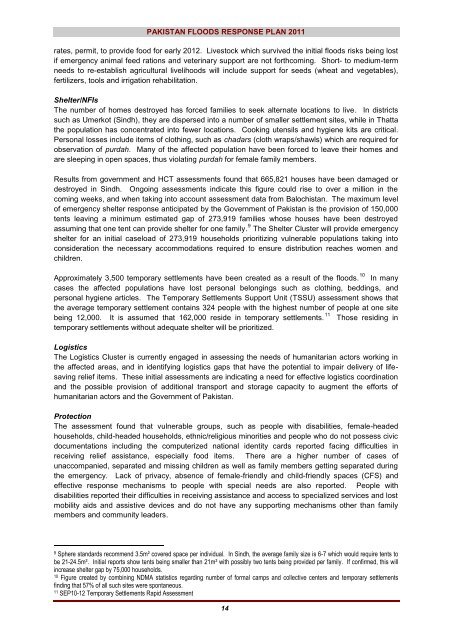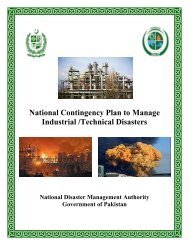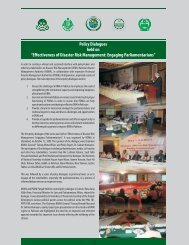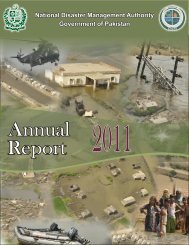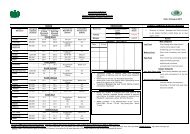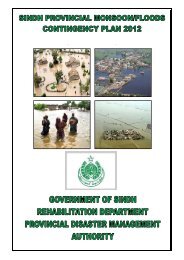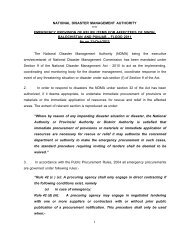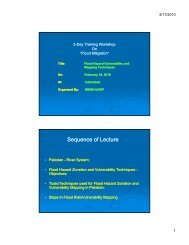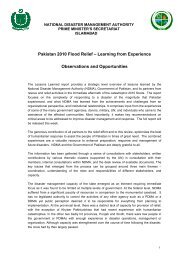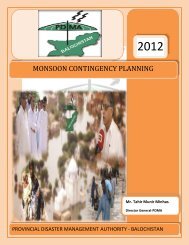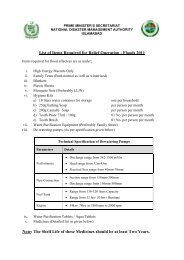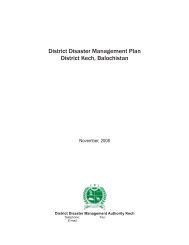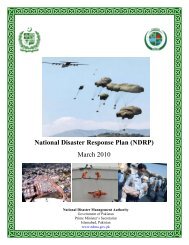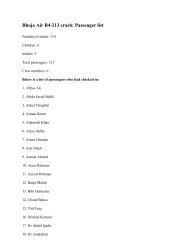Pakistan Floods 2011 - Humanitarian Response
Pakistan Floods 2011 - Humanitarian Response
Pakistan Floods 2011 - Humanitarian Response
- No tags were found...
Create successful ePaper yourself
Turn your PDF publications into a flip-book with our unique Google optimized e-Paper software.
F TheF ThoseF InPAKISTAN FLOODS RESPONSE PLAN <strong>2011</strong>rates, permit, to provide food for early 2012. Livestock which survived the initial floods risks being lostif emergency animal feed rations and veterinary support are not forthcoming. Short- to medium-termneeds to re-establish agricultural livelihoods will include support for seeds (wheat and vegetables),fertilizers, tools and irrigation rehabilitation.Shelter/NFIsThe number of homes destroyed has forced families to seek alternate locations to live. In districtssuch as Umerkot (Sindh), they are dispersed into a number of smaller settlement sites, while in Thattathe population has concentrated into fewer locations. Cooking utensils and hygiene kits are critical.Personal losses include items of clothing, such as chadars (cloth wraps/shawls) which are required forobservation of purdah. Many of the affected population have been forced to leave their homes andare sleeping in open spaces, thus violating purdah for female family members.Results from government and HCT assessments found that 665,821 houses have been damaged ordestroyed in Sindh. Ongoing assessments indicate this figure could rise to over a million in thecoming weeks, and when taking into account assessment data from Balochistan. The maximum levelof emergency shelter response anticipated by the Government of <strong>Pakistan</strong> is the provision of 150,000tents leaving a minimum estimated gap of 273,919 families whose houses have been destroyed9assuming that one tent can provide shelter for one family.F Shelter Cluster will provide emergencyshelter for an initial caseload of 273,919 households prioritizing vulnerable populations taking intoconsideration the necessary accommodations required to ensure distribution reaches women andchildren.Approximately 3,500 temporary settlements have been created as a result of the floods.F manycases the affected populations have lost personal belongings such as clothing, beddings, andpersonal hygiene articles. The Temporary Settlements Support Unit (TSSU) assessment shows thatthe average temporary settlement contains 324 people with the highest number of people at one site11being 12,000. It is assumed that 162,000 reside in temporary settlements. F residing intemporary settlements without adequate shelter will be prioritized.LogisticsThe Logistics Cluster is currently engaged in assessing the needs of humanitarian actors working inthe affected areas, and in identifying logistics gaps that have the potential to impair delivery of lifesavingrelief items. These initial assessments are indicating a need for effective logistics coordinationand the possible provision of additional transport and storage capacity to augment the efforts ofhumanitarian actors and the Government of <strong>Pakistan</strong>.ProtectionThe assessment found that vulnerable groups, such as people with disabilities, female-headedhouseholds, child-headed households, ethnic/religious minorities and people who do not possess civicdocumentations including the computerized national identity cards reported facing difficulties inreceiving relief assistance, especially food items. There are a higher number of cases ofunaccompanied, separated and missing children as well as family members getting separated duringthe emergency. Lack of privacy, absence of female-friendly and child-friendly spaces (CFS) andeffective response mechanisms to people with special needs are also reported. People withdisabilities reported their difficulties in receiving assistance and access to specialized services and lostmobility aids and assistive devices and do not have any supporting mechanisms other than familymembers and community leaders.109Sphere standards recommend 3.5m² covered space per individual. In Sindh, the average family size is 6-7 which would require tents tobe 21-24.5m². Initial reports show tents being smaller than 21m² with possibly two tents being provided per family. If confirmed, this willincrease shelter gap by 75,000 households.10Figure created by combining NDMA statistics regarding number of formal camps and collective centers and temporary settlementsfinding that 57% of all such sites were spontaneous.11SEP10-12 Temporary Settlements Rapid Assessment14


